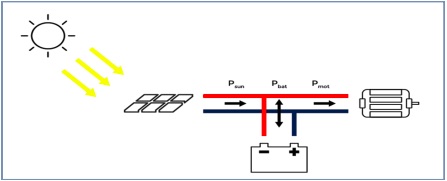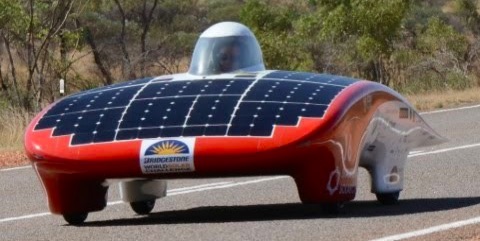Like this article and want to save it for later?
Download the article here:
Save Article Download
Australia has a long history and involvement with the development of solar powered cars
The Digger - 20 Jun 2019
Australia has a long history and involvement with the development of solar powered cars, starting with the Quiet Achiever in 1983. An all battery powered
vehicle designed and built by Larry & Garry Perkins and world famous adventurer Hans Thorstrup, little did they known that their crossing of Australia from
Perth to Sydney at a thundering average speed of 23km/h would inspire a whole generation of young engineers from all over the world to not only duplicate
this earlier achievement, but to take the concept and turn it into reality of a solar powered, sustainable family vehicle.
Are we there yet? the short answer is no. Yes, we have manufactures who can supply a variety of electric and electric-hybrid vehicles in Australia today.
Alas there are no commercial solar powered family cars available in Australia, and even if there were, at the moment, the price of such a vehicle would be so
astronomical that very few would or could afford or benefit from such a vehicle.
But still we dream and strive to build for the future. Every two years around 40 solar powered cars from more than 20 countries, race 3,000km across the
center of Australia from Darwin to Adelaide, taking part in the Bridgestone World Solar Challenge.
For years this event has been the showcase for solar car racing and allows the opportunity for Electric Vehicle manufactures to meet the local and international
teams, get to see the cars up close and snap up the best and brightest young engineers in battery pack development, systems and aerodynamics engineering.
Similar to the hotrod scene in the 1940’s and 50’s, when manufactures would visit club and enthusiasts (illegal) race meetings, to do the same very thing for
the motor industry.
So what is a Solar Powdered Car?
Solar cars use photovoltaic cells to convert sunlight into energy. Photovoltaic cells are the components in solar panels that convert the sun’s energy to
electricity. They’re made up of semiconductors, usually silicon, that absorbs the light, converting light to energy, which is either passed directly to an electric
motor, or can be stored in a battery for later use.

Who benefits from solar powered cars?
Solar cars have some key benefits. Their solar panels work silently so they don’t add to the noise pollution already on the road. Solar panels don’t create
greenhouse gases, as gasoline engines do. Most importantly, solar energy is free, widely available, and grants the solar car driver complete independence
from foreign oil.
Solar powered car design/technology
Solar cars combine technology found in the aerospace, bicycle, alternative energy and automotive industries. The design of a solar powered car is limited by
the necessity of getting lots of energy from the sun and storing that energy in batteries. Almost all solar cars ever built have been for the purpose of solar car
races.
Solar car racing the Bridgestone World Solar Challenge
Solar pioneer Hans Tholstrup initiated the World Solar Challenge after he & the Perkins drove their home-built solar car called the Quiet Achiever across
Australia from west to east in 1982. Inaugurated in 1987, the Bridgestone World Solar Challenge showcases the development of advanced automotive
technology and promotes alternatives to conventional automobiles.

Confirming their continuing 6 year title Sponsorship, Bridgestone Corporation in
conjunction with the event owners, the South Australia Tourism Commission,
are looking forward to the 2019 Bridgestone World Solar Challenge which will be held this
year between October 13 to October 20.
The challenge is a simple one:
Build a solar car that can travel from Darwin to Adelaide in the shortest possible time.
There are three main restrictions:
Vehicles may only be powered by direct solar radiation.
Vehicles must fit within a box of dimensions 5 meters in length X 1.8 meters in width X 1.6 meters height.
(Solar arrays can have an area of no more than 6 square meters.)
The event is conducted between the hours of 8:00 am and 5:00 pm daily.
Teams camp in the desert wherever they finish their day.
The first challenge in 1987 was a watershed. Twenty-three cars from seven countries entered. Runaway winner, General Motors’ Sunraycer, got all the
attention. It finished the race in just 44 hours, averaging 66.9 kilometers per hour. Sunraycer’s success had an enormous influence on the development of
General Motors electric vehicles.
The challenge has since become a testing ground for every facet of vehicle design for every facet of vehicle design from aerodynamics to tires. Auto giants
Ford, Honda, Toyota and Nissan participate.
The event is popular around the world. Japan and the United States have long held their own versions of the event with events also being held in Europe,
Malaysia, Taiwan, South Africa and the Middle East.
The Bridgestone World Solar Challenge is the premier forum for solar vehicle technology. It is the focus of the creative efforts of some of the companies and
engineering schools in the world and attracts worldwide media attention, books, documentaries and even a feature film.
Already Australian companies are benefitting from the development of the Solar Car
Australian Mining companies are supplying the raw materials: lead, selenium, tellurium, tin and zinc, which are critical to solar technology, as well as graphite,
lithium, and titanium, which are essential for EV’s and energy storage technologies to develop smaller and even more powerful batteries. The electrical vehicle
market alone is set to drive lithium-ion battery demand for decades to come, mineral’s such as carbine fibre and graphite used to construct, lightweight
composite material used exclusively in the aero space and formula one, only a few years ago is now used as a common by-product in the house hold goods
and of course in Solar Car construction.
Design elements foreshadowed in the solar challenge are now turning up in design concept and R&D vehicles.
Next issue we look more closely at the construction and team putting together an Australia entry into this years, Bridgestone Solar Car Challenge, 2019.





